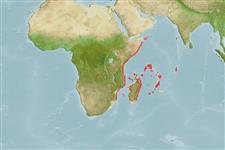Environment: milieu / climate zone / depth range / distribution range
Écologie
marin récifal; profondeur 3 - 40 m (Ref. 9710). Tropical; - 30°S
Western Indian Ocean: East Africa south to Durban, South Africa (Ref. 5372). Also found in oceanic islands.
Taille / Poids / Âge
Maturity: Lm ? range ? - ? cm
Max length : 12.0 cm TL mâle / non sexé; (Ref. 9710)
Description synthétique
Clés d'identification | Morphologie | Morphométrie
Épines dorsales (Total) : 13 - 14; Rayons mous dorsaux (Total) : 15 - 17; Épines anales: 3; Rayons mous anaux: 15 - 17. Black spot with white or bluish edges on its sides (Ref. 5372).
Usually seen alone or in pairs (specially during spawning) but occasionally in small groups, particularly in the vicinity of staghorn Acropora and Goniopora (Ref. 5503) thickets. Diet consists of live corals which makes it difficult to maintain in captivity (Ref. 4858). Little intraspecific nor interspecific aggressiveness (Ref. 5503). Oviparous (Ref. 205), monogamous (Ref. 52884). Form pairs during breeding (Ref. 205).
Life cycle and mating behavior
Maturities | Reproduction | Spawnings | Egg(s) | Fecundities | Larves
Distinct pairing (Ref. 205). Monogamous mating is observed as both obligate and social (Ref. 52884).
Allen, G.R., 1985. Butterfly and angelfishes of the world. Vol. 2. 3rd edit. in English. Mergus Publishers, Melle, Germany. (Ref. 4858)
Statut dans la liste rouge de l'IUCN (Ref. 130435)
Menace pour l'homme
Harmless
Utilisations par l'homme
Pêcheries: commercial; Aquarium: Commercial
Outils
Articles particuliers
Télécharger en XML
Sources Internet
Estimates based on models
Preferred temperature (Ref.
123201): 25.4 - 27.9, mean 26.9 °C (based on 64 cells).
Phylogenetic diversity index (Ref.
82804): PD
50 = 0.5000 [Uniqueness, from 0.5 = low to 2.0 = high].
Bayesian length-weight: a=0.02291 (0.01133 - 0.04632), b=3.00 (2.83 - 3.17), in cm total length, based on LWR estimates for this Genus-body shape (Ref.
93245).
Niveau trophique (Ref.
69278): 3.3 ±0.61 se; based on food items.
Résilience (Ref.
120179): Haut, temps minimum de doublement de population inférieur à 15 mois (Preliminary K or Fecundity.).
Fishing Vulnerability (Ref.
59153): Low vulnerability (10 of 100).
Nutrients (Ref.
124155): Calcium = 133 [67, 212] mg/100g; Iron = 0.975 [0.567, 1.669] mg/100g; Protein = 18.6 [17.4, 19.8] %; Omega3 = 0.125 [0.071, 0.217] g/100g; Selenium = 36 [19, 69] μg/100g; VitaminA = 48.3 [14.0, 170.0] μg/100g; Zinc = 1.7 [1.1, 2.5] mg/100g (wet weight);
